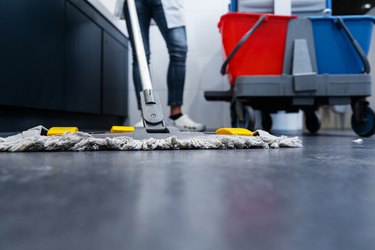
The smelly component of dog and cat urine is uric acid, and because cats tend to drink less than dogs, the concentration of this noxious chemical is more concentrated, making their urine more odorous. When pet urine sinks into the subfloor and dries out, the uric acid forms crystals that get reactivated by moisture, and it's a rare subfloor that doesn't have a small amount of moisture in it.
You can try one of many treatments to get the crystals -- and the smell -- out of your subfloor; enzymes and household cleaners may work, but it may come down to drastic measures, such as power washing or floor replacement.
Video of the Day
Video of the Day
A Basic Removal Procedure
If the smell is in the subfloor, you've probably already removed the floor covering, and if you haven't, that's the first job you need to do. It's doubtful you'll be able to salvage it. Whether you use a commercial odor remover or a household product, you need to first remove as much of the urine from the subfloor as possible.
Things You'll Need
Paper towels
Vinegar
Baking soda
Hydrogen peroxide
Vacuum
Enzyme cleaner
Shellac-based primer
Step 1: Sop Up the Moisture
Soak up any moisture from the affected area, using paper towels. Pour water on the stain and soak it up with more towels; keep doing this until the towels no longer turn yellow.
Step 2: Natural Subfloor Pet Odor Treatment
Choose a natural cleaner as your subfloor pet odor treatment. Choices include white vinegar, baking soda and hydrogen peroxide.
- Use vinegar full strength or mix it with warm water in a 30 percent solution.
- Sprinkle baking soda full strength.
- Use 3 percent hydrogen peroxide solution full strength. For a stronger cleaner, add a squirt of dish soap to the solution and sprinkle baking soda over the area after you apply this solution.
Step 3: Let It Soak
Pour the cleaner on the affected area and let it sit for about 10 minutes -- in the case of vinegar and peroxide -- or several hours, in the case of baking soda. Blot the area dry or vacuum up the powder. Let the area dry and check for odor. Repeat if necessary.
Step 4: Commercial Enzyme Cleaners
Use a commercial enzyme cleaner to remove the odor, following the instructions on the container. Enzyme cleaners for dog or cat urine naturally degrade the uric acid molecules, but the process can take weeks.
Step 5: Seal With Primer
Seal the subfloor with a coat of shellac-based primer after it's dry and most of the odor is gone. The primer locks whatever uric acid remains into the subfloor material and prevents odors from escaping.
Drastic Measures
An unusual amount of urine or unusually moist conditions in the subfloor can make odor remediation difficult, and in some cases, the only solution is to remove the affected part of the subfloor and replace it. Before you do that, you can employ an aggressive strategy that isn't appropriate for every room in your house.
Things You'll Need
Power washer
Wet/dry vacuum cleaner
Enzyme odor remover
Belt sander or floor sander
Shellac-based wood primer
Floor enamel
Step 1: Power Wash and Vacuum
Power wash the subfloor while a helper walks behind you and vacuums up the water with a wet/dry vacuum cleaner. Use a 25-degree nozzle and moderate pressure of about 2,000 pounds per square inch.
Step 2: Use Enzyme Products
Apply an enzyme odor-removing product to the entire floor while it is still wet. Let the floor dry completely, which takes several days.
Step 3: Remove the Top Layer
Sand off the top layer of wood, using a belt sander or flooring sander.
Step 4: Seal With Wood Primer
Seal the wood with shellac-based wood primer, then apply one or two coats of floor enamel. Let the paint dry for 48 hours before laying a floor covering.